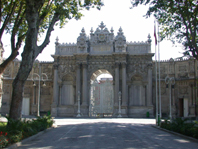|
|||||||||||||||||||||
|
Hereke is a unique weaving center located at the northern edge of Izmit Bay,
near Istanbul. The village of Hereke is recognized for producing the finest
hand knotted carpets in the world. These special carpets represent the pinnacle
of the Turkish carpet weaving tradition. Sultan Abdulmecid, Ottoman Emperor,
established the Hereke Imperial Factory in 1843 to produce carpets, fabric,
upholstery and curtains exclusively for the Ottoman Court.
The establishment of the Hereke Imperial Factory by Sultan Abdulmecid coincided with the construction of Dolmabahçe Palace, in Istanbul. Sultan Abdulmecid asserted that the greatest palaces in the world should also display the finest carpets in the world. A workshop was established on the grounds of Dolmabahçe Palace and staffed with Hereke weavers. The Hereke Imperial Factory and Hereke workshop at Dolmabahçe produced the magnificent carpets that decorate the palace. Over 140 large carpets and 115 prayer rugs were produced, totaling more than 48,000 square feet. Hereke designs were not only inspired by the motifs and compositions of traditional Turkish carpets, but also by the more elaborate curvilinear motifs of Persia and Mameluke Egypt. Many designs reflected contemporary Western European tastes. The Uþak medallion composition, used in Turkish rugs since the 16th century, was widely used at the Hereke factory. The intricacy of the designs and the sheer volume of knots needed made the construction of Hereke rugs a very lengthy process. The superlative quality of Hereke carpets was realized by combining the best carpet making techniques available, thus creating a new archetype. Hereke production was interrupted in 1878, when the factory burned to the ground, however, the Imperial Factory was rebuilt in 1882. During the late 19th and early 20th century, Hereke weavers produced their unique craft exclusively for the aristocracy of the Ottoman Empire, visiting dignitaries and heads of state. Fine Hereke hand knotted carpets were presented as gifts to the royal families of Japan, Russia, Germany and England. Demand steadily increased as Hereke carpets gained acclaim throughout Europe. As production increased, Hereke carpets became available in the markets of Istanbul. Hereke carpets received many prizes and medals for their outstanding quality. Vienna (1892), Lyon (1894), Bursa (1907), Vienna (1908), Brussels (1910 and 1911), Bursa (1911), Turin (1911), and Izmir (1921) |
 Hereke Weavers, circa 1890
Hereke Weavers, circa 1890 |
 Dolmabahçe Entrance Gate
Dolmabahçe Entrance Gate |
|
 A Hereke Carpet at Dolmabahçe
A Hereke Carpet at Dolmabahçe |
|
 Medals Awarded for Herekes
Medals Awarded for Herekes |
 |
 |
 |
|
Legal Notice | Privacy Statement Copyright © 2001-2003 Hereke Carpet Weavers Association. All rights reserved. Reproduction in whole or in part without permission is prohibited. |
||